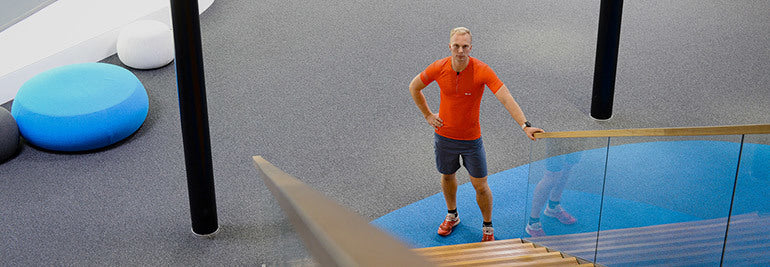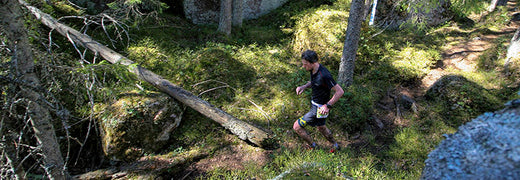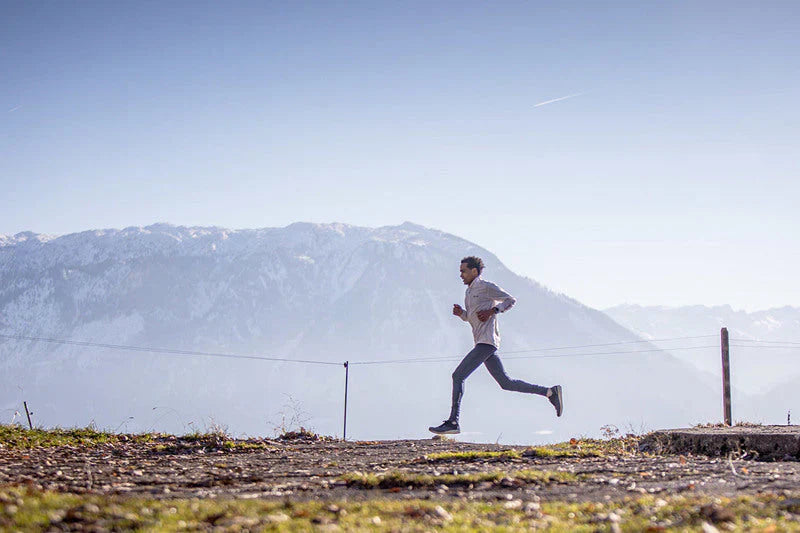

Suunto Blog

Fuelling the engine: talking nutrition with Melissa Hauschildt
Buying good quality and diverse produce and preparing nutritious meals is as important for our training as time spent running, cycling, swimming or at the gym. Yet, for many of us – especially for those of us with full time jobs and families – it’s tempting to cut corners when it comes to diet. We tell ourselves “next time”, and whip up a fast meal that fills the hole, but doesn’t fuel the engine.
Training is all about consistency and honesty. We shouldn’t try to fool ourselves; when we cut corners we don’t really gain in the long run. Instead, the training lifestyle is all about dedication to our sport, and the truth is, at the heart of that is caring for our bodies.
In this series of posts we explore how Suunto ambassadors and athletes keep their tanks fuelled. In this second instalment, we meet another Australian athlete, Melissa Hauschildt, an Ironman champion who recently set a new world record for fastest time (8:31:04) at the Ironman North American Championships, Texas in April.
The long term outlook
Good nutrition is a major part of Hauschildt’s life. Racing in Ironmans all over the planet, as the 35-year-old does, demands she feeds her engine with only the best fuel. “To be the best athlete I can I need to fuel my body correctly, but it's also important for life after sport,” she says. “I want to stay fit and healthy so I eat a healthy balanced diet.”
Maintaining good diet in busy times
Eating healthy can easily go out the window in busy times – how does Hauschildt maintain it? She prepares ahead of time. “I always have a healthy snack ready to go – nuts are always in abundance in my house, as well as bananas and apples,” she says. “I make almond butter and buckwheat bread at the start of the week so that’s always provides for great quick and easy snacks – almond butter and banana on toast or almond butter on apple.
“I also use Megaburn products. They make the best protein bars, with all natural ingredients, and so delicious! I always have a stack of them in the house. If I know it’ll take a while to make a meal after training, I will have a Megaburn protein shake immediately after so I can then take my time making a nutritious meal and not snack on junk.”
Natural is best
“I try to eat foods in their most natural form. I eat a lot of salad and vegetables, meat, nuts and eggs. I only eat full fat dairy. I make my own healthy treats as well, as my own bread and almond butter. I try to avoid packaged foods and refined sugar. I avoid soy, lentils, anything labeled ‘low fat’ or ‘diet’ and limit grains. I eat a lot of good fats - butter, olive and coconut oil, avocado, nuts, seeds, eggs.”
Easy, go-to meals
“My easy go-to meals tend to be a large salad with some meat. If I don't have any meat in the fridge I always have canned tuna and sardines in the cupboard or eggs. Another quick and easy go to meal for me is an omelette loaded with salad and left over meat or tuna.”
Kangaroo rice bowl
Ingredients:Wild riceKangaroo filletsRocketRed onionSnow peasTomatoShallotsCorianderAvocadoBlue cheeseOlive oilLime
Directions:
1. Cook rice to packet instructions. BBQ kangaroo fillets to medium/rare. Kangaroo gets very tough if overcooked. 2. Pre cut salads.3. Mix some olive oil and lime juice together for dressing. Grate some lime rind.4. Place cooked rice in bowl then arrange cut salads over it. Crumble some blue cheese on top. Sprinkle with lime rind. Pour over dressing.
Lead image: Photo by Ive Erhard on Unsplash.
READ MORE
Fuelling the engine: Talking nutrition with trail runner Lucy Bartholomew

Make everything count: 7 tips for office workers to get moving
At Suunto headquarters in Finland we try to practice what we preach. Which is why we have an in-house personal trainer to motivate us all to stay fit and healthy.
Matias Anthoni, 26, roams the offices, dropping by rooms, calling on us to get up and to join him for short exercise breaks on the spot. Resistance is futile!
Matias sees stairs as an opportunity to stay active.
“My job is to maintain the health and wellbeing of everyone at Suunto,” the former footballer turned trail runner says. “Everyone who works for the company can use me free of charge. I offer group exercise classes, personal sessions, nutritional advice, and random exercise breaks. Everyone understands it’s a great opportunity.”
Matias has a Bachelor in Sports and Health Promotion, and believes there are many opportunities throughout the day for office workers to take care of their bodies and minds. Here are his tips:
1. Everything counts
Remember this phrase and make it your mantra. It cuts through all the excuses about not having time. Sometimes we get stuck in an “all or nothing” mindset; if we can’t, for example, go for an hour long run or a full gym workout, we don’t do anything at all, failing to see the possibilities that are often right in front of our faces, and don’t take much time. Matias says it’s about thinking laterally, and making everything count.
2. Three x three minutes
Take three, three-minute exercise breaks a day. Set a timer on your phone, and do it. Invite your colleagues to join you. To get you started, here’s a short video of Matias demonstrating a few simple movements – try them! “Getting the blood flowing is good for the brain,” Matias says.
3. Go out of your way
When you need to go to the bathroom or get water or coffee, rather than going to the closest option, get in some extra movement and take an extra flight of stairs to do what you need on a floor above or below. Go out of your way for the sake of a little extra movement. It all counts.
4. Have walking meetings
When you have a simple catch up meeting that doesn’t require technology, why not make it a walk and talk? Aside from the movement, people are generally less distracted and more engaged at a walking meeting. You’ll breathe better, and will feel more energized.
5. Use your lunch breaks wisely
Have a 25 or 30-minute workout before you have lunch and you’ll have more energy for the rest of your day. It could even be 15 minutes. Remember, everything counts. Do what you can, rather than getting stuck in what you can’t. “Studies show a small amount of exercise goes a long way,” Matias says.
6. Create team challenges
Try to create a culture where you encourage one another to stay active. Create a challenge to see which department or team can do the most pull-ups in a month, or can walk the most steps in a month.
7. Plan your day
When you plan your day in advance you will know when you have windows for exercise or movement breaks. Planning means you are more likely to take advantage of these. Lock them in, and make them count.

Testing human physiology at the Norseman Xtreme Triathlon
© Kyle Meyr/nxtri.com
Ask Jonny Hisdal about the 226 km Isklar Norseman Xtreme Triathlon and you’ll get the honest truth. He should know afterall – not only has he completed the race course 12 times, as a physiologist he’s also researching what it does to the human body.
“Most of your biomarkers (chemicals, molecules, and hormones present in the blood indicating different forms of illness) are sky high when you reach the finish line,” he says. “If a doctor tested your blood immediately afterwards it would look like you are really sick, or having heart and kidney failure.”
© Kyle Meyr/nxtri.com
The good news is this alarming biomarker profile only lasts a short time. A day after the race the biomarkers are already on the way back down. Whereas, if you were really sick, the biomarkers would remain at the same level.
Hisdal is currently preparing to sample the blood of more than 40 finishers immediately after the end of the race, which starts on August 4. The goal is to understand what the normal blood levels are after such an extreme race. He’s also participated in a study looking at the possibilities and limitations of cold water swimming – the race includes a 3.8 km swim in a fjord with water temperature ranging between 13 and 15.5 °C.
To reach the finish line of the Norseman demands more than endurance fitness. “Yes, it requires really good base fitness, and a high level of endurance,” Hisdal says, “but also a lot of mental strength to compete for so many hours. The average athlete needs about fourteen fifteen hours.”
© Kyle Meyr/nxtri.com
Hisdal is also on the safety team for the race, and recently completed the course along with the rest of the crew, making it his 12th time. He first competed in the race as an athlete in 2005, and did so the following five years. Since then, he has been on the race organising team.
“The swimming is the easiest part, something that everyone should be able to do,” he says. “Average athletes are in the water for one and a half hours – that’s a long time if you are not used to it.”
“After that you jump on the bike and cycle for 180 km, including 3000 m elevation gain. If you are not used to cycling uphill it's impossible to do it. Then you are running 25 km on the flat, and the remaining 20 km uphill for 2000 m of ascent. It's brutal.”
© Kyle Meyr/nxtri.com
Some people, he says, quit before the race has even started. Others pull out 1000 m into the swim, and some on the bike during the climb. But the majority make the finish line, after giving their blood, sweat and tears to the terrain. “The biggest problem is people train too much so they get injured,” he says. “Almost everyone overtrains.”
Click here to see Suunto's range of triathlon watches!
The race has played a central role in popularising triathlon in Norway. Before it began in 2003, triathletes were hard to find in the country, whereas since the inaugural race triathlon clubs have been growing in membership. Only about 20 athletes signed up for the first race in 2003. Now, 4000 people from all over the world apply, vying for only 280 start positions.
“The reason why I do it is because it's an incredible experience, and it keeps me motivated to train and stay in shape,” Hisdal says. “It's not really like a normal competition; it's more like adventure or travelling. It's travelling through breathtaking geography, and also mentally; you travel through really deep lows and up to some really big highs.”
© Kyle Meyr/nxtri.com
Here are Hisdal’s five tips for the Isklar Norseman Xtreme Triathlon:
1. Train uphill
“It's essential to train uphill, both bike and running, because the race includes 5000 m of it.”
2. Get used to cold water
“It’s a necessity to train your swimming in cold water. It should not be the first time when you start the race because it will give you problems.”
3. Train longer sessions
“It’s important to have some long training sessions of at least six or seven hours so you know what you will experience during the race.”
4. Know your fuel
“You need to be able to eat and drink for the race length. What you should eat, when and how much, is something you need to practice well in advance. It's very individual. You need to learn what your body can tolerate.”
5. Race smart with a sports watch
“Learn to control your intensity with a sports watch like the new Suunto 9. The most important thing is not to start too hard. If you are too high in intensity in the first few hours you will suffer for the rest of the race.
“I have used sport watches and a heart rate monitor to make sure I'm not too high in intensity. I have a max heart rate I can tolerate, and if I reach that I slow down a little. It's very easy to be too eager in the beginning, when people are passing you. You are blinded by adrenaline at the start and cannot trust your feelings. You will feel very strong, but suddenly the hammer comes down and you're finished. Sport watches help manage this – just make sure your one has enough battery life.”
Suunto 3 Fitness Tracks Sleep Quality - What Can I Do to Improve It?
Thanks to your Suunto 3 you can see when things are heading in the right direction, know when it is time to stay the course, and when it’s time to make some changes. You can also follow along to learn which strategies and solutions are the most effective for you.
Here are 5 tips to improve your sleep quality
Avoid strenuous physical activity late in the evening.
Regular physical activity is an important part of a healthy lifestyle, but your body doesn’t stop working when you do. Your body can remain in an elevated state long after you finish a workout. As a result, your night time recovery levels may be delayed and diminished.
Establish a regular routine before bed.
We are all creatures of habit, and for the most part we have good instincts for what constitutes a good evening routine. A good stable routine signals your body that it’s time to start winding things down and allows your body to get head start on the work of recovery.
Regulate alcohol consumption.
A glass of wine in the evening is a popular way to relax in the evening, or a few drinks may help unwind after a stressful day. More than a few drinks, however, will almost certainly delay the onset of recovery at night and will result in poor recovery.
Improve your cardiorespiratory fitness (VO2max) with regular physical activity.
As if there weren’t enough reasons to improve your fitness level, here’s one more. The fitter you are the less your body is impacted by stress. You also become more resilient, so that when you do experience stress your body recovers more efficiently. This is true both day and night.
Sleep more.
It’s almost cruel, but sometimes the cause of bad sleep is… wait for it… bad sleep. Chronically poor sleep diminishes your body’s ability to repair itself. It also impairs your ability to interpret situations. This includes the ability to assess your own performance levels, losing touch with yourself and the impact of bad sleep on your effectiveness.
As you think about stress, recovery, and sleep in relation to your own daily routines and lifestyle decisions, it’s worth keeping in mind that stress increases your body’s need for good quality sleep. This is important because busy, hectic schedules that often produce a lot of stress also tend to result in the devaluation of sleep and recovery in favor of doing something more. In the long run, however, the health and productivity benefits of a balanced approach to stress and recovery are well worth it.
Blog post by Herman Bonner / Firstbeat
LEARN HOW TO USE SLEEP TRACKING ON SUUNTO 3 FITNESS

Congratulations to the Suunto Summit 2018 selections!
The 2018 Suunto Summiteers are:
Aniol, Spain
Daniel, Switzerland / Spain
Dmytro, Ukraine
Julia, Finland
Leonardo, Italy
Maggie, UK
Patrick, France
Patrik, Slovakia
Sherry, USA
Tara, USA
Teoh, Malaysia
Valentin, Romania
Verónica, Ecuador
(All participants have been individually contacted by Suunto.)
Welcome to #suuntosummit, everyone!
***** 5 February 2018 *****
Suunto Summit 2018
Do you want to be a part of a weekend full of trail running in the Finnish forest, workshops on Suunto products, and a little sauna too? If you can get to Helsinki for 4-6.5, we’ll do the rest!If this sounds like your kind of weekend, fill in the application below and tell us why you’re passionate about sports and Suunto, and share your story with #suuntosummit
Applications are due by 22.2.2018. (Amer Sports employees are not eligible for this Suunto Summit)
APPLY NOW
Here's what the Summit looks like in action!
In 2017 we hosted an inspiring group of 16 Suunto fans from around the world for a weekend of sharing experiences – and some muddy Finnish trails.
Summit team gearing up for the start of the trail race
Serene moment for Sante in the forest
Ready for orienteering?
Summiteers celebrating at the finish of Bodom Trail
All images by Philipp Reiter

Figure out your training zones and supercharge your fitness
Key components to improve your fitness are frequency, duration and intensity. Frequency and duration are easy to understand, but training intensity is a bit more tricky. How hard is hard? And why should I care? Read on to learn about intensity zones and about defining them.
That Janne Kallio works at Suunto on new product and solution concepts shouldn’t surprise anyone – after all, triathlon is his passion. Neither are we surprised that his book (Treenaa tehokkaasti, currently only available in Finnish) can help you learn to how to use technology to improve your endurance results. But the most surprising thing? Using training zones is easy. “Training does not need to be complicated,” says Kallio.
“The key aspect of reaching progress in one’s fitness is the ability to increase the physical load over longer period of time. Research shows that for people who are only starting to train, the easiest way to progress is to simply add one more training session in the week. Running three times a week versus two will improve fitness.”
But after a certain limit, simply running more is not enough.
“Running speed increases quite linearly on all distances up to about 60–70 km per week. After that the correlation isn’t as strong. When training more than 100 km a week your running speed does not necessarily get any faster.”
What Kallio is explaining is that adding volume to your training only helps up to a certain point. After that getting faster requires focus on other things, like the correct distribution of training intensity.
“Quite common training model is the so called polarized model where a big chunk, i.e. 80 % of training, is done aerobically, and a small portion of training with high-intensity. In order to follow this type of model one needs to be aware of one’s intensity levels.”
But what does intensity actually mean?
Training on different intensities stresses your body in different ways and leads to different kind of physiological adaptation. During light or moderate efforts the energy is supplied by the oxidative system, burning fat and carbs, and your blood lactate levels remain the same as at rest (0,8–1,5 mmol/L).
As the intensity increases, lactic acid starts to build in your muscles. Your body is still able to flush it out but the lactate levels rise above your resting levels. In training terminology this is your aerobic threshold (usually marked at 1,5–2,0 mmol/L).
If the intensity of the exercise intensifies even further, at some point your cardiovascular system can’t supply your muscles with enough oxygen, and lactic acid starts to build in your muscles faster than it can be removed. This point is called your anaerobic threshold (usually at around 4,0 mmol/L).
Based on these values, five zones are defined. Zones 1 and 2 are below aerobic threshold. Zones 3 and 4 between aerobic and anaerobic thresholds. Zone 5 is above your aerobic threshold. (Some of the zone-based models split zone 5 to fit dedicated sprint / explosive training into this intensity.)
Zone 1 is for recovery and warm-ups/cool-downs, zone 2 for long endurance sessions, zone 3 for tempo work, zone 4 for high-intensity intervals and zone 5 for maximal, VO2 max efforts.
The intensity zones are commonly defined based on heart rate, running pace or cycling power. Depending of the personal preference, type of training and equipment available one can use any of these models in their training.
How to define your personal heart rate zones?
It is important to know your zones to be able to follow a training plan and to keep structure in your training. “Without this knowledge easy runs often become too hard and hard ones are not hard enough. Zones help you understand and commit to what you are supposed to do,” Janne Kallio says.
There are basically three ways to define your heart rate zones: an estimate based on your max heart rate, a field test and a lab test.
Says Janne: “Statistically an estimate based on your max heart rate is valid, but as we know, individual differences are large especially in anaerobic threshold. The first challenge is the estimation of maximum heart rate and then the percentage of this to set the right level for anaerobic threshold. The percentage is an estimation as well.”
“The estimation of maximal heart rate is a good starting point. After some really hard workouts it’s definitely good to update your maximum heart rate based on personal experience. But for a goal oriented athlete, more accurate values are needed.”
The best way to get to know your personal HR zones is to take a VO2 max test with blood lactate analyses at a lab. But that is not necessary for every athlete. You can get a good idea of your personal intensity zones with a fairly straight-forward field test: After a good warm-up, run a 30-minute, race-pace effort. 10 minutes into the test hit the lap button on your Suunto. After the test use the average heart rate of the 20-minute lap as your anaerobic threshold.
Run hard the entire half an hour, but don’t start out too hard. After doing this test a few times you will learn to pace it better.
“After you have got your anaerobic threshold, it is time to make some calculations. There is some published research done on where the aerobic level fits based on anaerobic threshold,” says Janne. “It’s good to understand that an accurate anaerobic threshold is the basis of good zone distribution.”
Zone 5: Above your anaerobic threshold. Zone 5 ends at your max heart rateZone 4: 94–99 % of your anaerobic threshold. The upper limit of zone 4 is your anaerobic thresholdZone 3: 89-93 % of your anaerobic thresholdZone 2: 83-88 % of your anaerobic threshold. The upper limit of zone 2 is your aerobic thresholdZone 1: <82 % of your anaerobic threshold. Zone 1 starts at your resting heart rate.
Note, these % values are from anaerobic threshold heart rate, not from maximal heart rate.
There are also other zone models that you can use. For example some of the zone models place your anaerobic threshold within zone 4 and in some models zone 1 does not start at rest heart rate but above it at 55 % of maximum heart rate.
Kallio says that’s not really important – it’s about the concept: “What one needs to understand is that the role of the zones is to ensure you train in different intensities.”
Different activities, different intensity zones
“It is also good to know that your heart rate zones differ slightly in different endurance sports. Activities where more muscles are working also require more oxygen meaning your anaerobic threshold is higher in these sports. You will reach your anaerobic threshold earlier in swimming than in cycling, running or cross-country skiing – in this order,” Janne reminds us. “So if you are, let’s say, a cyclist and a runner, you should test and define your zones for each of the sports to target your training intensities correctly.”
It’s just one example of how a little knowledge can help out a lot – a whole lot.
LEARN HOW TO USE SUUNTO VERTICAL'S INTENSITY ZONES
Main image © Philipp Reiter














































































